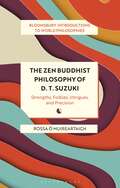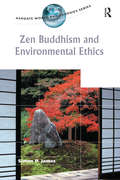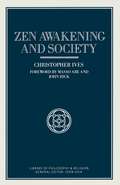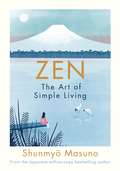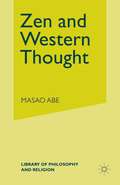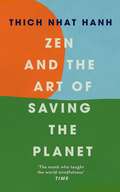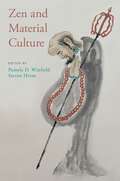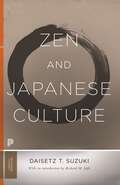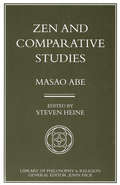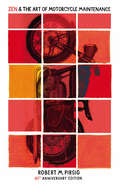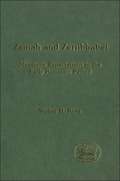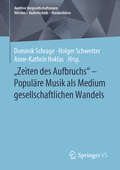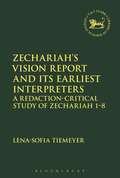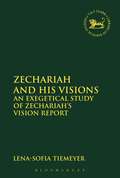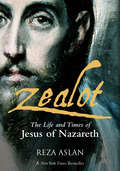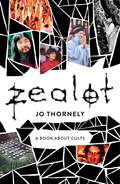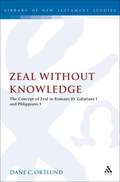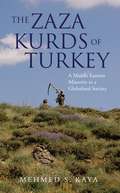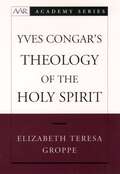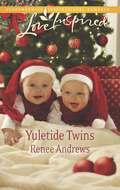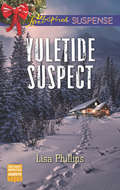- Table View
- List View
The Zen Buddhist Philosophy of D. T. Suzuki: Strengths, Foibles, Intrigues, and Precision (Bloomsbury Introductions to World Philosophies)
by Rossa Ó MuireartaighD.T. Suzuki (1870-1966) reached global fame for his writings on Zen Buddhism. In this introduction to his theories of self, knowledge, and the world, Suzuki is presented as a Buddhist philosopher in his own right.Beginning with a biography of his life providing the historical context to his thought and discussing Suzuki's influences, chapters cover the Zen notion of the non-self and Suzuki's Zen view of consciousness, language, and religious truths. His ideas about philosophy and radical views on rationality and faith come to life in two new complete translations of The Place of Peace in our Heart (1894) and Science and Religion (1949), which helps us to understand why Suzuki's description of Zen attracted the attention of many leading intellectuals and helped it become a household name in the English-speaking world.Offering the first complete overview of Suzuki's approach, reputation, and legacy as a philosopher, this is for anyone interested in the philosophical relevance and development of Mahayana Buddhism today.
The Zen Buddhist Philosophy of D. T. Suzuki: Strengths, Foibles, Intrigues, and Precision (Bloomsbury Introductions to World Philosophies)
by Rossa Ó MuireartaighD.T. Suzuki (1870-1966) reached global fame for his writings on Zen Buddhism. In this introduction to his theories of self, knowledge, and the world, Suzuki is presented as a Buddhist philosopher in his own right.Beginning with a biography of his life providing the historical context to his thought and discussing Suzuki's influences, chapters cover the Zen notion of the non-self and Suzuki's Zen view of consciousness, language, and religious truths. His ideas about philosophy and radical views on rationality and faith come to life in two new complete translations of The Place of Peace in our Heart (1894) and Science and Religion (1949), which helps us to understand why Suzuki's description of Zen attracted the attention of many leading intellectuals and helped it become a household name in the English-speaking world.Offering the first complete overview of Suzuki's approach, reputation, and legacy as a philosopher, this is for anyone interested in the philosophical relevance and development of Mahayana Buddhism today.
Zen Buddhism and Environmental Ethics (Ashgate World Philosophies Series)
by Simon P. JamesZen Buddhism and Environmental Ethics explores the implications of Zen Buddhist teachings and practices for our moral relations with the natural world. At once an accessible introduction to Zen and an important contribution to the debate concerning the environmental implications of the tradition, this book will appeal both to readers unfamiliar with East Asian thought and to those well versed in the field. In elucidating the philosophical implications of Zen, the author draws upon both Eastern and Western philosophy, situating the Zen understanding of nature within the Buddhist tradition, as well as relating it to the ideas of key Western philosophers such as Aristotle, Kant and Heidegger. These philosophical reflections on Zen are used to shed light on some prominent debates in contemporary environmental ethics concerning such issues as the intrinsic value of nature.
Zen Buddhism and Environmental Ethics (Ashgate World Philosophies Series)
by Simon P. JamesZen Buddhism and Environmental Ethics explores the implications of Zen Buddhist teachings and practices for our moral relations with the natural world. At once an accessible introduction to Zen and an important contribution to the debate concerning the environmental implications of the tradition, this book will appeal both to readers unfamiliar with East Asian thought and to those well versed in the field. In elucidating the philosophical implications of Zen, the author draws upon both Eastern and Western philosophy, situating the Zen understanding of nature within the Buddhist tradition, as well as relating it to the ideas of key Western philosophers such as Aristotle, Kant and Heidegger. These philosophical reflections on Zen are used to shed light on some prominent debates in contemporary environmental ethics concerning such issues as the intrinsic value of nature.
Zen Awakening and Society (Library of Philosophy and Religion)
by Christopher IvesZen Buddhism has traditionally focused on monastic practice and the artistic expression of awakening (satori) but has paid little explicit attention to social ethics. This book considers the relationship between Zen and social ethics.
Zen: The Art of Simple Living
by Shunmyo Masuno'Does for mental clutter what Marie Kondo has done for household clutter' Publisher's WeeklyA beautifully illustrated guide to slowing down, finding true happiness and feeling calm, by Zen Buddhist monk Shunmyo Masuno. _________Zen is the perfect antidote to the chaos of modern life . . . In clear, practical and easy to follow lessons - one a day for 100 days - renowned Buddhist monk Shunmyo Masuno draws on centuries of wisdom to show you how to apply the essence of Zen to modern life. You will learn how to exhale deeply to eliminate negative emotions, to arrange your house simply to clear your thinking, to line up your shoes at night to bring order to your mind, to plant a single flower and watch it grow, to worry less about what you cannot control, and so much more . . .You will even make time to think about nothing at all.Simplify your life with the art of Zen, and learn how to feel more relaxed, fulfilled, and with a renewed sense of peace. __________'This little treasure needs to be at every bedside' llan Lokos, author of Through the Flames, Patience, and Pocket Peace'Zen: The Art of Simple Living makes the wisdom of the Buddha radically accessible' Dzogchen Ponlop Rinpoche, author of Emotional Rescue and Rebel Buddha
Zen and Western Thought: A Third Sequel To Zen And Western Thought (Library of Philosophy and Religion)
by Masao AbeZen and the Art of Saving the Planet
by Thich Nhat Hanh'The monk who taught the world mindfulness' TimeIn this masterful work, one of the most revered spiritual leaders in the world today shares his wisdom on how to be the change we want to see in the world. In these troubling times we all yearn for a better world. But many of us feel powerless and uncertain what we can do. Thich Nhat Hanh (Thay) is blazingly clear: there's one thing that we have the power to change-and which can make all the difference: our mind. How we see and think about things determines all the choices we make, the everyday actions we take (or avoid), how we relate to those we love (or oppose), and how we react in a crisis or when things don't go our way.Filled with powerful examples of engaged action he himself has undertaken, inspiring Buddhist parables, and accessible daily meditations, this powerful spiritual guide offers us a path forward, opening us to the possibilities of change and how we can contribute to the collective awakening and environmental revolution our fractured world so desperately needs.
Zen and Material Culture
by Pamela D. Winfield Steven HeineThe stereotype of Zen Buddhism as a minimalistic or even immaterial meditative tradition persists in the Euro-American cultural imagination. This volume calls attention to the vast range of "stuff" in Zen by highlighting the material abundance and iconic range of the Soto, Rinzai, and Obaku sects in Japan. Chapters on beads, bowls, buildings, staffs, statues, rags, robes, and even retail commodities in America all shed new light on overlooked items of lay and monastic practice in both historical and contemporary perspectives. Nine authors from the cognate fields of art history, religious studies, and the history of material culture analyze these "Zen matters" in all four senses of the phrase: the interdisciplinary study of Zen's matters (objects and images) ultimately speaks to larger Zen matters (ideas, ideals) that matter (in the predicate sense) to both male and female practitioners, often because such matters (economic considerations) help to ensure the cultural and institutional survival of the tradition. Zen and Material Culture expands the study of Japanese Zen Buddhism to include material inquiry as an important complement to mainly textual, institutional, or ritual studies. It also broadens the traditional purview of art history by incorporating the visual culture of everyday Zen objects and images into the canon of recognized masterpieces by elite artists. Finally, the volume extends Japanese material and visual cultural studies into new research territory by taking up Zen's rich trove of materia liturgica and supplementing the largely secular approach to studying Japanese popular culture. This groundbreaking volume will be a resource for anyone whose interests lie at the intersection of Zen art, architecture, history, ritual, tea ceremony, women's studies, and the fine line between Buddhist materiality and materialism.
Zen and Japanese Culture (Bollingen Series #334)
by Daisetz T. SuzukiZen and Japanese Culture is a classic that has influenced generations of readers and played a major role in shaping conceptions of Zen’s influence on Japanese traditional arts. In simple and poetic language, Daisetz Suzuki describes Zen and its historical evolution. He connects Zen to the philosophy of the samurai, and subtly portrays the relationship between Zen and swordsmanship, haiku, tea ceremonies, and the Japanese love of nature. Suzuki uses anecdotes, poetry, and illustrations of silk screens, calligraphy, and architecture. The book features an introduction by Richard Jaffe that acquaints readers with Suzuki’s life and career and analyzes the book’s reception in light of contemporary criticism, especially by scholars of Japanese Buddhism. Zen and Japanese Culture is a valuable source for those wishing to understand Zen in the context of Japanese life and art, and remains one of the leading works on the subject.
Zen and Japanese Culture: Not Assigned (Bollingen Series (General) #334)
by Daisetz T. Suzuki Richard M. JaffeZen and Japanese Culture is a classic that has influenced generations of readers and played a major role in shaping conceptions of Zen’s influence on Japanese traditional arts. In simple and poetic language, Daisetz Suzuki describes Zen and its historical evolution. He connects Zen to the philosophy of the samurai, and subtly portrays the relationship between Zen and swordsmanship, haiku, tea ceremonies, and the Japanese love of nature. Suzuki uses anecdotes, poetry, and illustrations of silk screens, calligraphy, and architecture. The book features an introduction by Richard Jaffe that acquaints readers with Suzuki’s life and career and analyzes the book’s reception in light of contemporary criticism, especially by scholars of Japanese Buddhism. Zen and Japanese Culture is a valuable source for those wishing to understand Zen in the context of Japanese life and art, and remains one of the leading works on the subject.
Zen and Comparative Studies (Library of Philosophy and Religion)
by M. AbeZen is not a religion of God. Nor a religion of faith. It is a religion of emptiness, a religion of absolute nothingness. However it is not nihilistic but dynamically positive. For Zen is based on self-awakening, awakening to the self. In this book, a sequel to Zen and Western Thought, the author tries to clarify the true meaning of Buddhist emptiness in comparison with Aristotelian notion of substance and Whiteheadron notion of process. He also emphasises that Buddhism completely defies and overcomes dualism, but it is not monistic, but rather nondualistic. What is Nondualism? This is one of the important themes of this book.
Zen And The Art Of Motorcycle Maintenance: 40th Anniversary Edition (P. S. Series)
by Robert PirsigAcclaimed as one of the most exciting books in the history of American letters, this modern epic became an instant bestseller upon publication in 1974, transforming a generation and continuing to inspire millions. A narration of a summer motorcycle trip undertaken by a father and his son, the book becomes a personal and philosophical odyssey into fundamental questions of how to live. Resonant with the confusions of existence, Zen and the Art of Motorcycle Maintenance is a touching and transcendent book of life.
Zemah and Zerubbabel: Messianic Expectations in the Early Postexilic Period (The Library of Hebrew Bible/Old Testament Studies)
by Wolter H. RoseIt has often been argued that Zerubbabel, the Jewish governor of Yehud at the time of the rebuilding of the temple (late 6th century BCE), was viewed by the prophets Haggai and Zechariah as the new king in the line of David. In this new study, Rose offers a contrary proposal for the interpretation of the oracles in Haggai 2 and Zechariah 3 and 6. He traces their background in the pre-exilic prophets, pays special attention to often neglected details of semantics and metaphor, and concludes that neither Haggai nor Zechariah designated Zerubbabel as the new king in Jerusalem. Instead, the oracles in Zechariah 3 and 6 should be seen as fully messianic.
"Zeiten des Aufbruchs" - Populäre Musik als Medium gesellschaftlichen Wandels (Auditive Vergesellschaftungen Hörsinn - Audiotechnik - Musikerleben)
Dieser Band fragt nach dem Beitrag der populären Musik zu den gesellschaftlichen Transformationen der 1960er bis 1980er Jahre und verbindet kultursoziologische, musik- und kulturwissenschaftliche Perspektiven. Welchen neuartigen Erlebensweisen, welchen sozialen Akteursgruppen verschafft Musik Geltung? Viele zeitgenössische Akteure, aber auch akademische Arbeiten deuten das Auftreten neuer Musikstile (Beat, Rock, Punk etc.) auf der Bühne der Geschichte als Bestandteil eines befürworteten gesellschaftlichen „Aufbruchs“ (jeweils neuer Generationskohorten). Der Band beobachtet diese Metapher des Aufbruchs indes als eine feldtypische Deutung, anhand derer das Zusammenwirken von Musik und gesellschaftlichen Transformationen bereits kenntlich wird.
Zechariah’s Vision Report and Its Earliest Interpreters: A Redaction-Critical Study of Zechariah 1-8 (The Library of Hebrew Bible/Old Testament Studies #626)
by Lena-Sofia TiemeyerIf Zechariah's vision report (Zechariah 1.8-6.8) reflects the seer's visionary experience, how does that impact our understanding of the gradual growth of the text? Lena-Sofia Tiemeyer builds on the work done in her previous book Zechariah and His Visions (Bloomsbury-T&T Clark, 2014), to demonstrate that the visionary material forms the primary textual layer. The oracular texts constitute chronologically later interpretations. Zechariah and/or later authors/editors sought guidance in the earlier vision accounts, and the oracular material reflects these endeavours. Tiemeyer's investigation is guided by the question: what is the latter material doing with the former? Is it enforcing, contradicting, or adding to it? Using a ratio composed of the difference between the intratexts and intertexts of Zech 1-8, Tiemeyer shows how this ratio is higher in the oracular material than in the visionary material. This difference points to the different origin and the different purpose of the two sets of material. While the earlier vision report draws on images found primarily in other biblical vision reports, the later oracular material has the characteristics of scribal interpretation. By drawing on earlier material, it seeks to anchor its proposed interpretations of the various vision accounts within the Israelite textual tradition. It is clear that the divine oracles were added to give, modify, and specify the meaning of the earlier vision report.
Zechariah and His Visions: An Exegetical Study of Zechariah's Vision Report (The Library of Hebrew Bible/Old Testament Studies #605)
by Lena-Sofia TiemeyerDid Zechariah really see visions? This question cannot be definitely answered, so the idea must remain a hypothesis. Here, Tiemeyer shows that this hypothesis is nonetheless reasonable and instrumental in shedding light on matters in Zechariah's vision report that are otherwise unclear. Tracking through each verse of the text, the key exegetical problems are covered, including the topics of the distinction between visions and dreams, dream classification, conflicting sources of evidence for dream experiences, and rhetorical imagery as opposed to dream experience. Further attention is focused on the transmission of the divine message to Zechariah, with the key question raised of whether a visual or oral impression is described. Tiemeyer's study further demonstrates that Zech 1-6 depicts a three-tier reality. This description seeks to convey the seer's visionary experience to his readers. In a trance state, Zechariah communicates with the Interpreting Angel, while also receiving glimpses of a deeper reality known as the 'visionary world.'
Zealot: The Life and Times of Jesus of Nazareth
by Reza AslanFrom the internationally bestselling author of No god but God comes a fascinating, provocative and meticulously researched biography that challenges long-held assumptions about the man we know as Jesus of Nazareth. Two thousand years ago, an itinerant Jewish preacher from Galilee launched a revolutionary movement proclaiming the 'Kingdom of God', and threatened the established order of first-century Palestine. Defying both Imperial Rome and its collaborators in the Jewish religious hierarchy, he was captured, tortured and executed as a state criminal. Within decades, his followers would call him the Son of God. Sifting through centuries of mythmaking, Reza Aslan sheds new light on one of history's most influential and enigmatic figures by examining Jesus within the context of the times in which he lived: the age of zealotry, an era awash in apocalyptic fervour, when scores of Jewish prophets and would-be messiahs wandered the Holy Land bearing messages from God. They also espoused a fervent nationalism that made resistance to Roman occupation a sacred duty. Balancing the Jesus of the Gospels against historical sources, Aslan describes a complex figure: a man of peace who exhorted his followers to arm themselves; an exorcist and faith healer who urged his disciples to keep his identity secret; and the seditious 'King of the Jews', whose promise of liberation from Rome went unfulfilled in his lifetime. Aslan explores why the early Church preferred to promulgate an image of Jesus as a peaceful spiritual teacher rather than a politically conscious revolutionary, and grapples with the riddle of how Jesus understood himself. Zealot provides a fresh perspective on one of the greatest stories ever told. The result is a thought-provoking, elegantly written biography with the pulse of a fast-paced novel, and a singularly brilliant portrait of a man, a time and the birth of a religion.
Zealot: A book about cults
by Jo Thornely'a smart, daring and refreshing book.' - Weekend Australian 'deliciously sinister' - Herald SunWhy would anyone join a cult? Maybe they're unhappy with their current religion, or they want to change the world, or they're disappointed with their lives and want to find something bigger or holier that makes sense of this confusing, chaotic and dangerous world. Or maybe they just want to give themselves the best possible chance of having sex with aliens.Whatever the reason, once people are in, it's usually very difficult for them to leave. Cults have ways of making their followers do loopy, dangerous stuff to prove their loyalty, and in return they get a chance to feel secure within the cult's embrace, with an added bonus of being utterly terrified of the outside world. From the tragic JONESTOWN Kool-Aid drinkers to the Australian cult THE FAMILY to the fiery Waco climax of THE BRANCH DAVIDIANS, this book is a wide-sweeping look at cults around the world, from the host of the popular podcast ZEALOT.'a piss-taker of rare boldness.' - Weekend Australian
Zeal Without Knowledge: The Concept of Zeal in Romans 10, Galatians 1, and Philippians 3 (The Library of New Testament Studies #472)
by Dane C. OrtlundThis book examines the concept of 'zeal' in three Pauline texts (Rom 10:2; Gal 1:14; Phil 3:6) as a way-in to discussion of the 'New Perspective' on Paul.  The concept of zeal has been discussed in a sustained way by James D. G. Dunn, who argues that Paul was drawing on a long and venerable tradition of Jewish zeal for the nation of Israel, that is, a concern to maintain Israel's distinction from the surrounding nations by defending and reinforcing its boundaries. Ortlund interacts with Dunn, agreeing that this concern for distinctiveness was a crucial, and neglected, concern of Paul's before his conversion. Nevertheless, Ortlund contends that Dunn has presented an overly narrow understanding of Pauline zeal that does not sufficiently locate zeal in the broader picture of general obedience to Torah in Jewish tradition. As such, Ortlund shows in this work that zeal refers most immediately to general obedience to Torah - including, but not to be centrally circumscribed as, ethnic distinction.
The Zaza Kurds of Turkey: A Middle Eastern Minority in a Globalised Society (Library of Modern Middle East Studies)
by Mehmed S. KayaTurkey, at the very intersection of Europe and the Middle East, comprises a plethora of ethnicities and minority groups. There is however very little official data about many of its chief minorities. The Zazas are one such group: a Kurdish people speaking the Zaza dialect, and living as a distinct people in the eastern Anatolian provinces. Originally followers of Zoroastrianism from c.700 BC, over the centuries the Zazas converted, often by force, to Sunni Islam or Alevism, which remain the key faiths of the Zazas today. While many Zazas have migrated to Turkey's major cities and beyond, the majority of the population remain in rural eastern Anatolia and have retained a society and culture largely untouched by the influences of the modern world.Mehmet S. Kaya here provides a thorough investigation of all aspects of Zaza life, including kinship, economy, culture, identity, gender relations, patriarchy and religion. His fieldwork among local communities in the Zaza area, together with insights drawn from the Kurdish and Turkish media, sheds light upon the ways in which this Middle Eastern minority has maintained its way of life and cultural identity. He observes the ways in which the Zazas govern their problems and conflicts outside of official legal administration and courts; the factors which make Zaza society adhere in the absence of formal authority; and the role of religion in daily Zaza life. Kaya also examines the concept of the Zazas as a 'stateless' people, and looks at the issue of the oppression of minority ethnic identities in the context of Turkish nationalism.The Zaza Kurds of Turkey provides access to the world of a little-known people who have so far been largely neglected in the academic literature. This important study will be of interest to the fields of Middle East Studies, Islamic Studies, Anthropology, and Minority and Diaspora Studies.
Zahlenwerk: Kalkulation, Organisation und Gesellschaft (Organisation und Gesellschaft)
by Andrea Mennicken Hendrik VollmerInwiefern die massenhafte Mobilisierung von Zahlen und Rechenpraktiken die Aufrechterhaltung sozialer Ordnung ermöglicht oder in Mitleidenschaft zieht, hat in den Sozialwissenschaften bislang wenig systematische Beachtung gefunden. Auch die Diskussion über organisiertes Rechnen, die im englischsprachigen Raum unter dem Oberbegriff des "Accounting" geführt wird, ist weitgehend auf Spezialistenkreise beschränkt geblieben. Mit Beiträgen zum Umgang mit Zahlen in Organisationen, Wirtschaft und Gesellschaft dokumentiert der Band "Zahlenwerke" eine nun allmählich erwachende sozialwissenschaftliche Aufmerksamkeit und zeigt dabei neben interdisziplinären Berührungspunkten zwischen Soziologie und Betriebswirtschaftslehre auch solche zwischen organisations- und gesellschaftstheoretischen sowie kulturwissenschaftlichen Ansätzen auf.
Yves Congar's Theology of the Holy Spirit (AAR Academy Series)
by Elizabeth Teresa GroppeThe French Dominican theologian Yves Congar is recognized by many as the most important Roman Catholic ecclesiologist of the 20th century. He was the thinker behind some of the major decrees of the Second Vatican council. He was also a leader in the ecumenical movement in Europe throughout most of the century. Despite his importance, there are few books about Congar in English. Congar's pneumatology, argues Groppe, can enrich various ongoing theological discussions, including reflection as to whether the church should be hierarchical or a democracy, the development of "persons in communion" as a framework for contemporary theological anthropology and ecclesiology, and deliberations about the personhood of the Holy Spirit.
Yuletide Twins (Mills & Boon Love Inspired): Sweetheart Bride Yuletide Twins
by Renee AndrewsAlone and pregnant with twins is not how Laura Holland wants to spend her holidays. So she seeks out the only person who's never let her down: old college friend David Presley.
